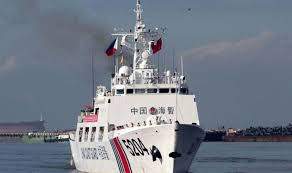South China Sea threat: Beijing to boost armed police and coastguard as tensions soar

Proposals include centralising command of the People’s Armed Police and giving it more resources and powers. China’s 1.5 million-strong armed police force is mainly responsible for internal security, riot control, anti-terrorism and law enforcement. But protecting maritime rights also falls within its remit and China's coastguard, whose vessels are increasingly seen in the disputed waters of the South China Sea, comes under its control.
The proposals would see the armed police come directly under the command of the Communist Party’s Central Committee as well as the Central Military Commission (CMC), both of which are chaired by President Xi Jinping.
They also out the tasks of the paramilitary force including defence and combat at sea, such as scenarios in which weapons can be used.
The plans now have to be reviewed and approved by the Standing Committee of the National People’s Congress in Beijing.
China’s coastguard has been at the front line as tensions rise in the South China Sea, where Beijing is embroiled in territorial disputes with Hanoi and other rival claimants.
Earlier this month, a Vietnamese fishing boat sank after a collision with a Chinese coastguard vessel near the contested Paracel Islands, with both sides claiming their ships had been rammed.
Collin Koh, a research fellow at the S Rajaratnam School of International Studies at Singapore’s Nanyang Technological University, said the latest move was about unifying command and leadership structures.
He told the South China Morning Post: “This doesn’t appear to only influence the manner in which Chinese maritime law enforcement is conducted, but also how agencies such as China’s coastguard would work more closely with the People’s Liberation Army in peacetime contingencies including that involving China’s maritime sovereignty and rights.
“This could potentially mean more integration between these forces along the civil-military fusion line that’s been in the works for years.”
Tensions threatened to boil over last week when an Australian frigate joined three US warships involved in a stand-off with a Chinese vessel exploring for oil in waters claimed by Vietnam and Malaysia.
The US Navy initially deployed two vessels, the USS America amphibious assault ship and the USS Bunker Hill guided-missile cruiser, close to where the Chinese government survey ship Haiyang Dizhi 8 was operating.
The ships were later joined by Australia's HMAS Parramatta and a third US vessel, the destroyer USS Barry.
Data from ship-tracking website Marine Traffic showed the Haiyang Dizhi 8 was 202 miles off the Malaysian coast, within its exclusive economic zone.
The ship, accompanied by an armed Chinese coastguard vessel, moved in a hash-shaped pattern consistent with a seismic survey for nearly a week.
The area is near waters claimed by both Vietnam and Malaysia as well as China.
China claims most of the energy-rich South China Sea, within a U-shaped "nine-dash line" on its maps, which is not recognised by its neighbours.
Malaysia state oil firm Petronas, which is also carrying out exploratory work in the area, and the foreign ministry in Kuala Lumpur, have not commented.
But the US has called on China to stop its "bullying behaviour" in the South China Sea.
Beijing has denied reports of a standoff, saying the Haiyang Dizhi 8 was conducting normal activities.
The US has accused China of pushing its presence in the South China Sea while other claimants are pre-occupied with the coronavirus pandemic.
Vietnam protested after China said it had established two administrative districts on the Paracel and Spratly islands in the disputed waters. China has called Vietnam's claims illegal.
Separately, Taiwan's Defence Ministry said a Chinese aircraft carrier group lead by China's first aircraft carrier, the Liaoning, had ended a mission in the South China Sea and was now heading east through the Bashi Channel, which separates Taiwan from the Philippines.
The carrier group earlier this month sailed down Taiwan's east coast. China said at the time it was on its way to routine exercises in the South China Sea.
Photo: Chinese coastguard on patrol in the South China Sea (Image: GETTY)




